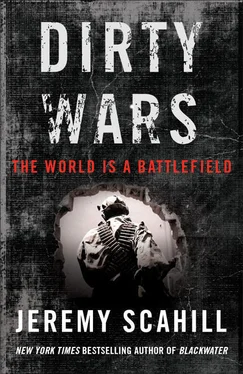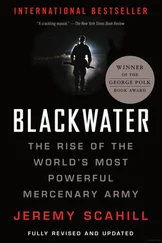In his sermons, Awlaki would weave his theories about the United States being at war with Islam with condemnations of torture, at times taking his theories into the realm of conspiracy, particularly in his denunciations of human rights organizations. “The Jews and the Christians will not be pleased until you become like them. How can we have trust in the leaders of kufr [disbelief] when today, today, right now, right now, there are Muslim brothers in jail?” Awlaki declared in a lecture in Britain, his voice shaking with passion. “Every sinister method of interrogation is used against them. They would use against them homosexuals to rape them. They would bring their mothers and sisters and wives and they would rape them in front of these brothers. Now it’s true that this is not happening in the West, but the West knows about it. The United Nations knows about it. Amnesty International knows about it and they’re doing nothing. In fact, sometimes they are encouraging it.”
Meleagrou-Hitchens has pointed out that in all of his time in Britain, Awlaki did not “make clear and public statements in support of violent jihad in a contemporary Western context,” adding that “although Awlaki sought to spark an Islamist political awakening within his audience, he was not openly calling for violent jihad against Western countries.” While Awlaki lectured on jihad and used historical Arab texts, such as Book of Jihad, authored by Ibn Nuhaas, a fourteenth-century scholar who died fighting against the Moguls and the Crusaders, he was careful in offering his rationale. “I want to state in the beginning and make it very clear that our study of this book is not an exhortation or an invitation to violence or a promotion of violence against an individual or society or a state,” Awlaki said in one lecture on the book. “We are studying a book that is 600 years old…so that is the extent of what we are doing. It’s a purely academic study of an old traditional book.” It was clear that Awlaki was thinking of his next move, and Meleagrou-Hitchens believed that his “disclaimer” about not calling for violence “was likely made with the intention of avoiding the attention of British security authorities.”
Awlaki’s stock among young, English-speaking Muslims on the street was rising by the day, but his solitary life in Britain, away from his wife and children, was not sustainable.
Ultimately, Awlaki decided to return to Sana’a. Nasser Awlaki said it was because Anwar had been unable to afford to live in the West and wanted to pursue business and educational opportunities in Yemen. But some of Anwar’s associates in the United Kingdom had a different view. Usama Hasan, who had fought against the Soviets in Afghanistan, suggested that Awlaki wanted to put his money where his mouth was. “I’ve got a feeling that he’s always been yearning for it [to fight jihad], and our yearning was satiated in a way, but he never got that outlet,” he said. “Add to that his strong links to Yemen, which has extensive connections to al-Qaeda, and the pull to jihad was too strong.”

13. “You Don’t Have to Prove to Anyone That You Did Right”
IRAQ, 2003–2005—Once the Iraq War was in full swing, Rumsfeld directed General John Abizaid, the CENTCOM commander, to disband the separate High Value Task Forces JSOC was running in Afghanistan and Iraq, TF-5 and TF-20. Instead, JSOC would run one unified task force, TF-121, that would have jurisdiction to operate and hit in both countries. The logic was that “tracking and then capturing or killing Qaeda and Taliban leaders or fleeing members of the former Iraqi government required planning and missions not restricted by the lines on the map of a region where borders are porous.” It was a further blurring of the lines between “covert” and “clandestine” missions, but Rumsfeld had determined JSOC should forge ahead. In keeping with Rumsfeld’s drive to make Special Operations Forces the lead agency in the “global manhunt,” the task force would be run by McRaven and overseen by McChrystal, and they would have at their disposal the full range of US intelligence assets, including what was needed from the CIA. In addition to McRaven’s Navy SEALs and McChrystal’s Rangers, as well as members of Delta Force, the team would also have command over paramilitaries from the CIA’s Special Activities Division and support from the Activity, JSOC’s signals intelligence wing.
The days of JSOC operatives being regularly put on loan to the CIA were over. Cambone’s Strategic Support Branch and the Activity were coordinating the feeding of all-access intel to the task force. “This is tightening the sensor-to-shooter loop,” a senior defense official told the Washington Times . “You have your own intelligence right with the guys who do the shooting and grabbing. All the information under one roof.”
While TF-121 was given a mission to kill or capture Osama bin Laden and Saddam Hussein by the spring of 2004, Washington was increasingly focused on Iraq. Veteran intelligence officials identify this period as a turning point in the hunt for bin Laden. At a time when JSOC was asking for more resources and permissions to pursue targets inside of Pakistan and other countries, there was a tectonic shift toward making Iraq the numberone priority.
The heavy costs of that strategic redirection to the larger counterterrorism mission were of deep concern to Lieutenant Colonel Anthony Shaffer, a senior military intelligence officer who was CIA trained and had worked for the DIA and JSOC. Shaffer ran a task force, Stratus Ivy, that was part of a program started in the late 1990s code-named Able Danger. Utilizing what was then cutting-edge “data mining” technology, the program was operated by military intelligence and the Special Operations Command and aimed at identifying al Qaeda cells globally. Shaffer and some of his Able Danger colleagues claimed that they had uncovered several of the 9/11 hijackers a year before the attacks but that no action was taken against them. He told the 9/11 Commission he felt frustrated when the program was shut down and believed it was one of the few effective tools the United States had in the fight against al Qaeda pre-9/11. After the attacks, Shaffer volunteered for active duty and became the commander of the DIA’s Operating Base Alpha, which Shaffer said “conducted clandestine antiterrorist operations” in Africa. Shaffer was running the secret program, targeting al Qaeda figures who might flee Afghanistan and seek shelter in Somalia, Liberia and other African nations. It “was the first DIA covert action of the post–Cold War era, where my officers used an African national military proxy to hunt down and kill al Qaeda terrorists,” Shaffer recalled.
Like many other experienced intelligence officers who had been tracking al Qaeda prior to 9/11, Shaffer believed that the focus was finally placed correctly on destroying the terror network and killing or capturing its leaders. But then all resources were repurposed for the Iraq invasion. “I saw the Bush administration lunacy up close and personal,” Shaffer said. After a year and a half of running the African ops, “I was forced to shut down Operating Base Alpha so that its resources could be used for the Iraq invasion.”
Shaffer was reassigned as an intelligence planner on the DIA team that helped feed information on possible Iraqi WMD sites to the advance JSOC teams that covertly entered Iraq ahead of the invasion. “It yielded nothing,” he alleged. “As we now know, no WMD were ever found.” He believed that shifting the focus and resources to Iraq was a grave error that allowed bin Laden to continue operating for nearly another decade. Shaffer was eventually sent to Afghanistan, where he would clash with US military leaders over his proposals to run operations into Pakistan to target the al Qaeda leaders who were hiding there.
Читать дальше













